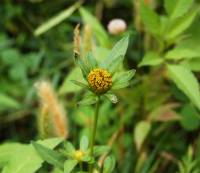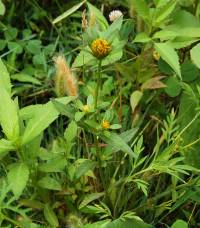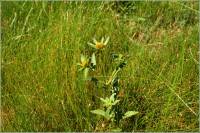Probably more or less infrequent to frequent throughout the state in moist or wet habitats about lakes, along streams and ditches, and on borders of ponds and swamps.
Annuals, (5-)20-70(-200) cm. Leaves sessile or petioles 5-15(-35+) mm (± winged); blades ± elliptic to ovate or lanceolate, 40-80(-150+) × 15-40(-60+) mm, sometimes laciniately 1-pinnatisect with 1-4+ lobes near bases, bases cuneate, margins entire or dentate to serrate, usually ciliate, apices acute to acuminate, faces glabrous or hirtellous. Heads borne singly or in 2s or 3s. Peduncles 10-40(-80) mm. Calyculi of (2-)6-7(-10) ± spreading, oblanceolate or lanceolate to linear, ± foliaceous bractlets or bracts 7-35(-60) mm, margins (entire or serrate) sometimes sparsely ciliate, abaxial faces hispidulous near bases, distally glabrous. Involucres campanulate to hemispheric or broader, (4-)5-7(-12) × (3-)6-12(-15+) mm. Phyllaries (6-)7-8(-13), elliptic-ovate to lance-ovate, (4-)6-9(-12) mm. Ray florets usually 0, sometimes 1-5; laminae orange yellowish, 4-8 mm. Disc florets (5-)20-60(-150+); corollas pale yellow to orange, (2-)3-4 mm (gradually ampliate, anthers usually pale). Cypselae blackish to purplish or brown, ± flattened, sometimes weakly 3(-4)-angled, usually cuneate to linear, outer (3-)6-7(-10) mm, inner (4-)6-9(-11) mm, margins proximally antrorsely to patently, distally retrorsely, barbed, apices ± truncate to concave, faces ± 1-nerved, usually smooth, seldom notably tuberculate, glabrous or sparsely strigillose; pappi 0, or of (1-)3-3(-4+) ± erect to spreading, retrorsely barbed awns (0.2-)2-3(-6) mm. 2n = 48.
Flowering Aug-Oct. Marshes and other wet sites; 10-1700 m; Alta., B.C., Man., Que.; Ala., Alaska, Calif., Colo., Conn., Del., D.C., Ga., Ill., Ind., Iowa, Kans., Ky., La., Maine, Md., Mass., Mich., Minn., Miss., Mo., Mont., Nebr., N.H., N.J., N.Mex., N.Y., N.C., N.Dak., Ohio, Okla., Oreg., Pa., R.I., S.C., S.Dak., Tenn., Tex., Utah, Vt., Va., Wash., W.Va., Wis., Wyo.; Europe; Asia; n Africa; introduced in Pacific Islands, Australia.
Plants with cypsela mid-nerves strongly developed (cypselae more or less strongly 4-angled and, often, tuberculate) that are treated below as Bidens connata have been included in B. tripartita, perhaps rightly so. And some botanists have included (or advocated inclusion of) B. eatonii, B. heterodoxa, and/or B. infirma in B. tripartita, as well, perhaps rightly so.
Note added 2012-08-01: The above description and comments apply to Bidens tripartita sensu lato. In both the Intermountain Flora and A Utah Flora, B. comosa is treated as distinct from B. tripartita. Information on how the authors involved distinguish the two will be added later. The distribution map of B. tripartita may include specimens of B. comosa. They will need to be re-examined to determine whether this is the case, a task that will take time. [Mary E. Barkworth]
Much like no. 5 [Bidens connata Muhl.], but differing in a fairly well correlated set of characters; stem stramineous; lvs sessile or petiolate, merely toothed; outer invol bracts relatively large and leafy; disk-cors 4(5)-lobed, pale yellow or greenish-yellow; anthers included; achenes 5-10 mm, smooth except for the retrorse marginal barbels, very flat, the median nerves inconspicuous (or the outer one sometimes a little raised distally); pappus of (2)3(4) awns, the median awn(s) shorter than the lateral ones; 2n=24. Disturbed habitats, often somewhat drier than those of no. 5; widespread in c. and e. U.S. and adj. Can., s. to N.C. and Mo., and w. sporadically into the w. cordillera. Aug.-Oct. (B. acuta)
Gleason, Henry A. & Cronquist, Arthur J. 1991. Manual of vascular plants of northeastern United States and adjacent Canada. lxxv + 910 pp.
©The New York Botanical Garden. All rights reserved. Used by permission.













